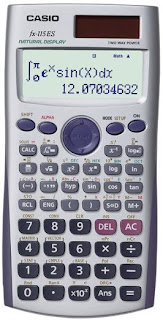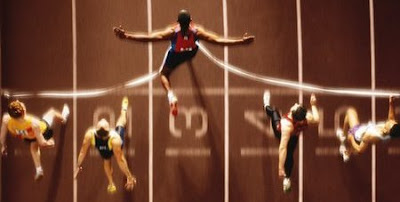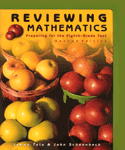
How hard is it to add the graph of a function to a photograph? Not very hard, if you have the right software, as I discovered last week. But the real question is why? A few weeks ago I stumbled on an article about a photographer who adds math functions to her photographs. A sample photograph of her work is shown on the right. Immediately, the gears in my head started turning, "I remember working with software that can do this…. I smell a classroom activity or possibly even a math contest on flickr."
The problem was that I couldn't remember the name of the software. I tried several: Graph, MathGV, and http://fooplot.com/. All of them are free, but none of them could add pictures to the graph. Then I remembered an engineering marvel called GeoGebra. Its free software for high school geometry and algebra, and most importantly, you can add pictures to your graphs.
Here are the steps to add the graph of a function to a photograph:
- Upload (or download) a photograph to your computer.
- Download GeoGebra from the website: http://www.geogebra.org/cms/en/download. If you don't want to install it (or can't) on your computer, choose "Applet Start."
- Run GeoGebra.
- Add the photograph. Click on the down arrow over the purple pinwheel. A menu will pop up. Select "Insert Image." Browse to the image.
- Show the coordinate axes. Right-click on the picture. Choose "Object Properties." Select the "Style" tab and then move the "Filling" cursor to around 25. You should be able to see through the picture.
- Move the picture using the "Move" tool. When you are done, set it as the background. Right-click the picture. Check off "Background Image" under the "Basic" tab.
- Type in a function in the input box at the bottom. For example, type in
y=x^2and press enter. - Re-save the picture with the graph. Select File>>Export>>Graphics View as Picture. A dialog box will pop up. Accept the defaults and press "Save."
Tips
- If you move the graph of the function with the "Move" tool, the equation will auto-magically update.
- You can change the color of the functions.
- Don't forget to change the "Filling" of the picture back to 100 (step 5) when you are done.
Was that so hard? Your students don't have to go through all these hoops if you create a GeoGebra file with the picture pre-loaded. Tailor the allowed functions for your class. For example, in a first-year Algebra class (that still hasn't covered quadratics), allow only linear functions.
Now for the contest: upload your pictures to flickr.com, join the "amscomath" group by going here, and then click "Send to group" from the photo page. OR, if flickr is blocked in your school, then you can email the photos to:
amscomath AT live DOT com
Pictures will be judged on originality, creativity, and correctness. The following would make a neat picture (hint): a golden rectangle superimposed over a person's face or body.
First prize is a free book. The contest ends on May 10 at 12 p.m.
Have fun!
Blog: Amsco Extra! (Login to Add to MyJacketFlap)
JacketFlap tags: Programming, ACT, Mathematics Competitions, Statistics, Technology, Math, Add a tag
 For the revision to our ACT book, Preparing for the ACT: Mathematics and Science Reasoning, we purchased a cheap scientific calculator from Casio, the fx-115 ES, and I was amazed at the power of this pocket calculator. The calculator sells for about $20 (or less depending on where you purchase it), and can:
For the revision to our ACT book, Preparing for the ACT: Mathematics and Science Reasoning, we purchased a cheap scientific calculator from Casio, the fx-115 ES, and I was amazed at the power of this pocket calculator. The calculator sells for about $20 (or less depending on where you purchase it), and can:
- work with percents, fractions, and mixed numbers
- simplify radical expressions
- express answers in terms of pi
- do operations with complex numbers
- find permutations and combinations
- perform one-variable statistics (including frequency tables)
- solve one variable equations
- do operations with matrices
- calculate integrals
- do all the usual things that a scientific calculator can do (like radicals, powers, trig functions, etc.)
To top it off, the darn thing runs on solar power! The geek in me can’t help but say, “Wow!” It’s proof that technology can be cheap and powerful (I’m talking to you, Apple.) I called the ACT twice just to confirm that this calculator is allowed on the test.
ACT Tip: If you are planning on taking the ACT test and can’t afford (or don’t want to bother with) a graphing calculator, you can’t go wrong with the fx-115 ES. You are not going to find a TI model with similar capabilities for the same price.
Note/Warning: The ACT is a timed test – you have an average of 1 minute per question. This means two things: (1) Buying a calculator that you are not accustomed to using right before the test is a big mistake. (2) While using an advanced calculator can be helpful in the classroom, you probably won’t have time to use the advanced features on the ACT test. The Casio fx-115 ES’s features that will be useful on the ACT are fractions, mixed numbers, simplifying radical expressions, expressing answers in terms of pi, and operations with complex numbers.
To conclude today’s post, here is the promised potpourri of links:
- Engineers beat math PH.D’s in math contest. The contest: The Netflix Prize. Make Netflix’s movie recommendation system more accurate by 10%. The math: statistics.
- We’re all probably going to speak Chinese one day. A group of computer science students from China created one of the most awesome pieces of software I’ve seen in a long time: PhotoSketch (see the video below). It takes a hand-drawn sketch tagged with the name of the object and turns it into a real-world photo. It works in one of those “Why didn’t I think of that?” ways – the software does a web search based on the tags and chooses pictures that match the sketch. The best matches are then combined together and the user chooses the best looking image. The results are pretty amazing – check out the video below.
- The Making of a Mathlete. PBS is going to air a documentary about the International Math Olympiad. Need I say more? No, really, it actually looks pretty exciting.
PhotoSketch: Internet Image Montage from tao chen on Vimeo.
Blog: Amsco Extra! (Login to Add to MyJacketFlap)
JacketFlap tags: Mathematics Competitions, Math, Test Preparation, Add a tag
 I decided to look into the wonderful universe of mathematics competitions available for the 6-12 planet. Mathematics competitions have traditionally kept teachers busy during prep periods, when they coach high achievers. It is, after all, mathematics competitions that rank talent in science and mathematics. There are different types of competitions: the kind where talented students participate for fun, trophies, stipends, and scholarships, and the kind used to rank countries and regions--such as the Trends in International Mathematics and Science Study.
I decided to look into the wonderful universe of mathematics competitions available for the 6-12 planet. Mathematics competitions have traditionally kept teachers busy during prep periods, when they coach high achievers. It is, after all, mathematics competitions that rank talent in science and mathematics. There are different types of competitions: the kind where talented students participate for fun, trophies, stipends, and scholarships, and the kind used to rank countries and regions--such as the Trends in International Mathematics and Science Study.
Which mathematics contests are the best? The answer to this question depends on the objectives of the participants. If the objective is to show off talent, then regional and international competitions are the way to go; if the objective is to compete for the sake of competition, then local and national competitions are the way to go. Other determining factors are time available for preparation and number of interested students. Where to look for competition information? Well, there is always Wikipedia for global competition information. For starters, I found an extensive list of competitions worldwide at List of Mathematics Competitions.
For Fun and Competition
 Now in its 31st year, Math Olympiads stands out among mathematics competitions. Held annually in Bellmore, New York, Math Olympiads for Elementary and Middle Schools (MOEMS), is a program that last year drew 150,000 students representing 6,000 teams. The founder of Math Olympiads, Dr. George Lenchner, had a impressive life as an educator, which may inspire students. Organizing a Math Olympiads team at your school can certainly motivate students to intensify their study of mathematics.
Now in its 31st year, Math Olympiads stands out among mathematics competitions. Held annually in Bellmore, New York, Math Olympiads for Elementary and Middle Schools (MOEMS), is a program that last year drew 150,000 students representing 6,000 teams. The founder of Math Olympiads, Dr. George Lenchner, had a impressive life as an educator, which may inspire students. Organizing a Math Olympiads team at your school can certainly motivate students to intensify their study of mathematics. Started in 1959 in Romania, International Mathematics Olympiad is the oldest mathematics competition. This contest focuses on problem solving and sophisticated solutions. The intended audience can range from college professors to high school students to younger, gifted students of mathematics. The competition requires contestants to apply mathematics in an a priori, or deductive, way. For example, try this problem:
Started in 1959 in Romania, International Mathematics Olympiad is the oldest mathematics competition. This contest focuses on problem solving and sophisticated solutions. The intended audience can range from college professors to high school students to younger, gifted students of mathematics. The competition requires contestants to apply mathematics in an a priori, or deductive, way. For example, try this problem: In a mathematical competition, in which 6 problems were posed to the participants, every two of these problems were solved by more than 2/5 of the contestants. Moreover, no contestant solved all the 6 problems. Show that there are at least 2 contestants who solved exactly 5 problems each.
The contest has prizes and can motivate students to develop their problem solving skills.
For Prizes and Scholarships
On an international level, there is the Mathematical Kangaroo, adopted by about forty countries. Founded by an Australian educator, Peter Joseph O'Halloran, with the Trust Foundation, this competition is aimed at helping the disadvantaged and is currently used from North America to Europe to Asia.
International Comparison Competitions
Now for the competitions that neither reward prizes nor distribute trophies, but have the sole purpose of comparing and ordering countries and regions: Trends in International Mathematics and Science Study (TIMSS); Progress in International Reading Literacy Study (PIRLS); Program for International Student Assessment (PISA); and Program for the International Assessment of Adult Competencies (PIAAC), scheduled to begin in 2011. These contests have taken a greater hold in debates about educational policy and mathematics education. Most of these competitions are used to assess the overall content-specific knowledge of an international pool of participants.
Training
I found that there is plethora of mathematics competitions. Choosing one is a matter of doing the research and defining your goals for your students.

Once you start training for the competition, Amsco can help. Visit our Web site and navigate to Book Information for in-depth information about our mathematics books. For middle-school students, try Reviewing Mathematics: Preparing for the Eighth-Grade Test to develop problem-solving skills. High school students will be challenged by Preparing for Qualifying Exams in Mathematics, Preparing for the SAT Mathematics , and Preparing for the ACT: Mathematics and Science Reasoning, among other titles.
Good luck!


